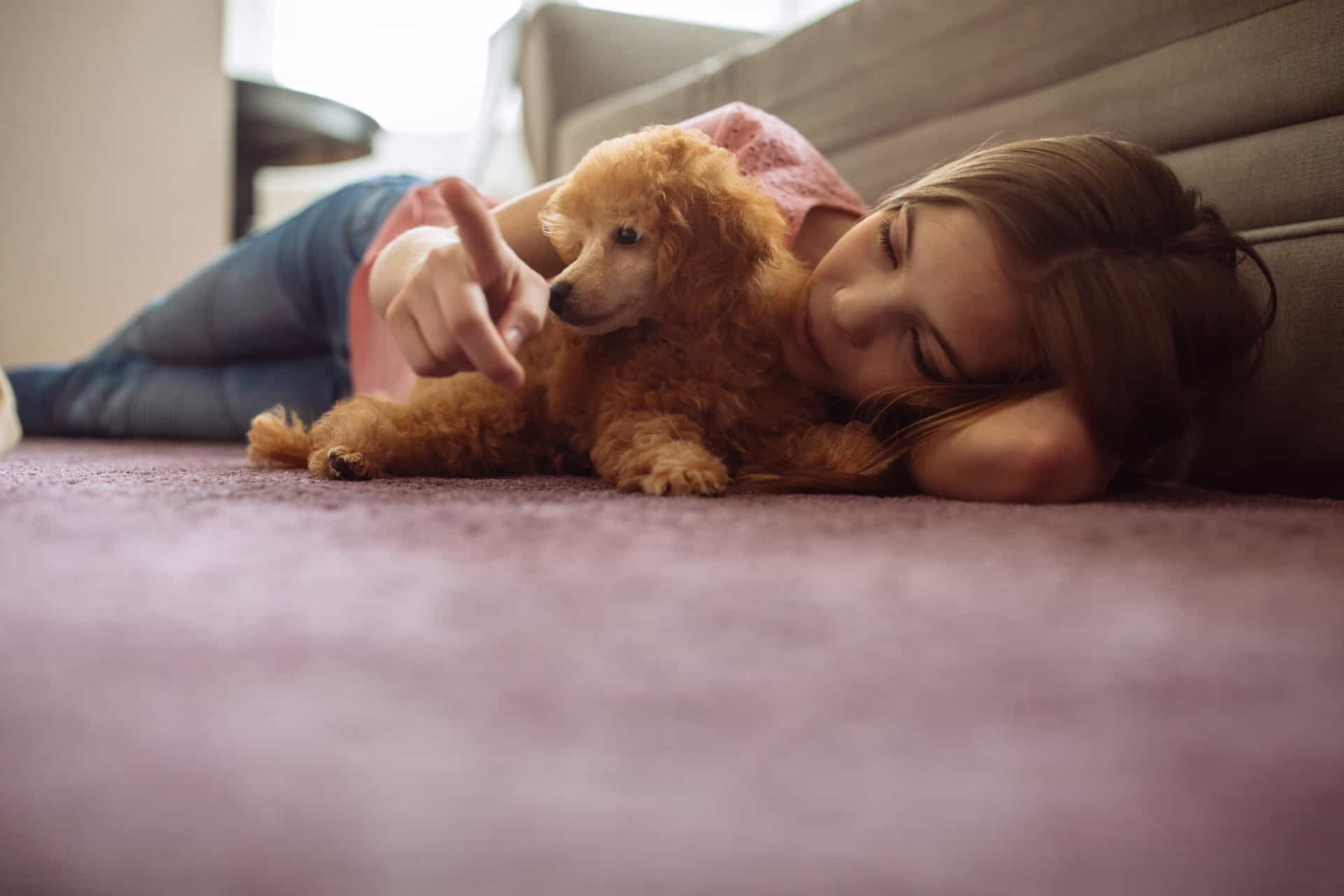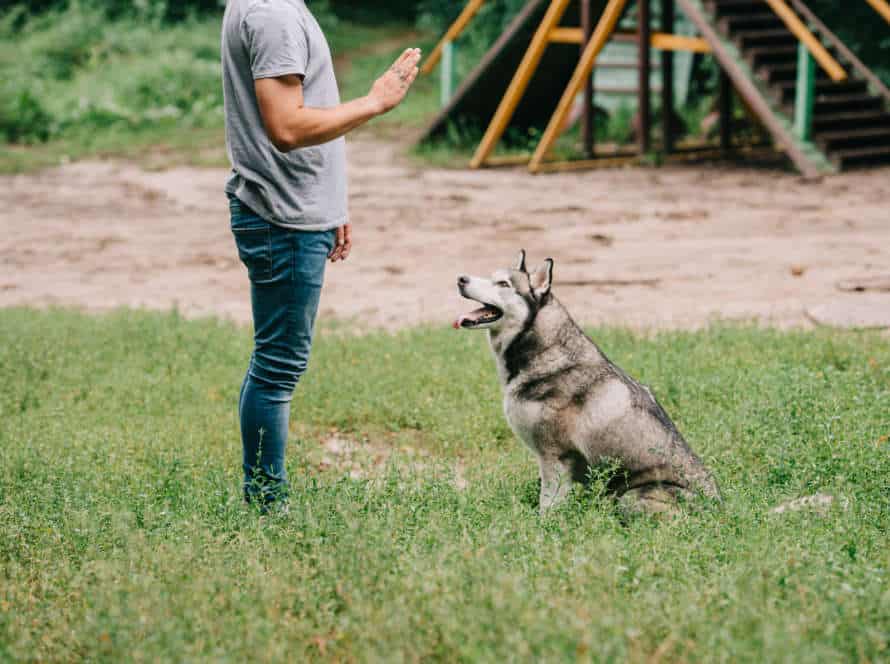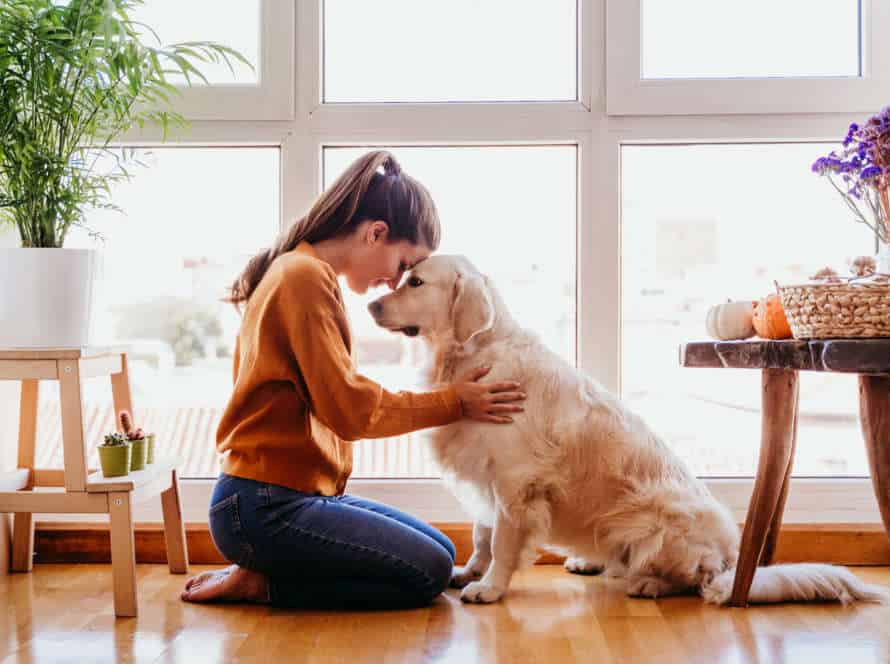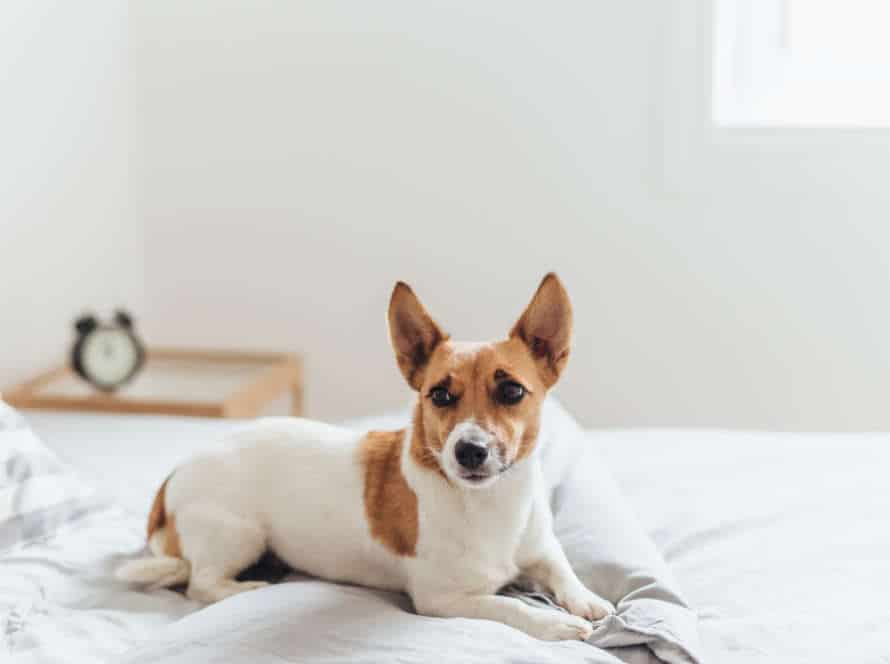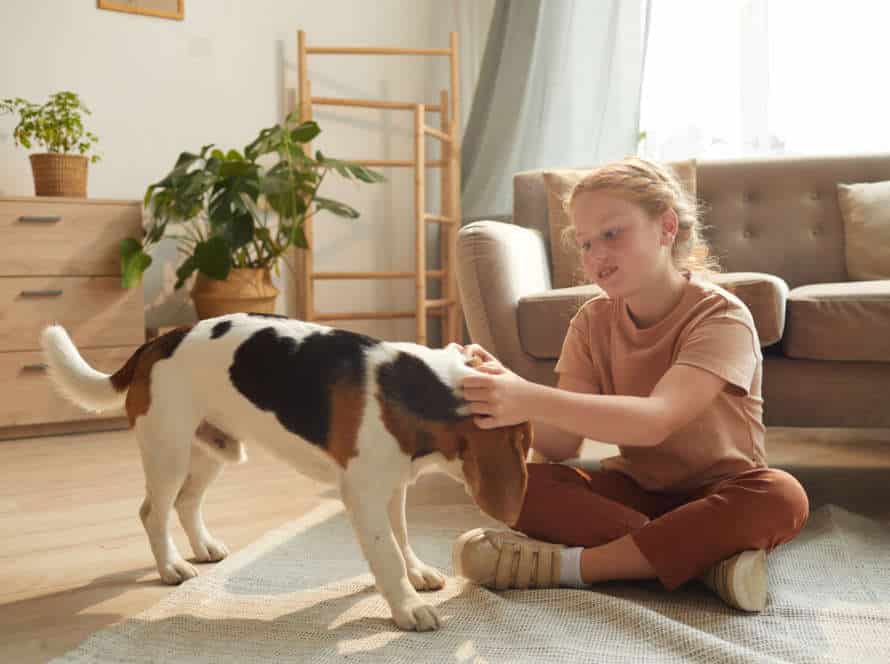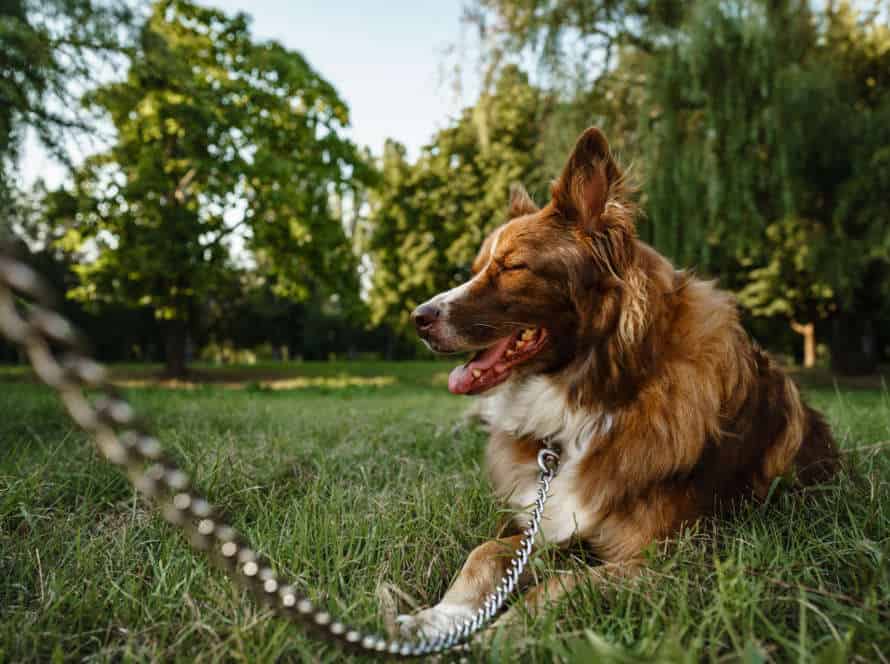Teaching Bite Inhibition: A Crucial Skill for Puppies
Teaching bite inhibition is essential for pups. It helps them gain self-control and stops injuries to people and other animals. Here’s what to do:
- Start by having fun with your pup and letting them mouth your hands.
- If they bite too hard, make a high pitched yelp and instantly stop playing. This teaches your pup that biting hard ends playtime.
- If they keep biting hard, stand up and leave for a few minutes. This shows your pup that biting means losing attention.
- Give praise and rewards when they do gentle, controlled mouthing.
- Repeat this consistently and your pup will learn to regulate the force of their bite.
Understanding Bite Inhibition in Puppies
Bite inhibition is key for pups. With guidance, they can control the force of their bite and know not to bite humans or animals. This helps avoid painful bites and stops aggressive behavior from forming.
Let’s look at how to teach bite inhibition to your pup!
What is bite inhibition and why it’s important to teach puppies?
Bite inhibition is important – it’s the process of teaching puppies to control their bite force. Young dogs bite as part of normal development. Therefore, it’s critical to train them to control their biting before they become adults.
Bite inhibition teaches dogs not to bite hard enough to cause injury, even during play. If a dog has practiced bite inhibition, they will instinctively hold their bite pressure low if an accident happens.
Here’s how to teach your puppy bite inhibition:
- Play with your puppy gently and observe their behavior.
- When puppy bites too hard, pause the game and make a shrill sound.
- After the sound, walk away. Show affection only when bearable biting resumes.
Bite inhibition is essential for safety. It also helps create a strong bond between the owner and the pup that will last forever.
Understanding the bite force of puppies
Gaining knowledge of the bite force of puppies is vital for tutoring them to control their bite. Puppies use their mouths to explore and play with other animals and people. If not given instructions, their biting can become hazardous.
To teach bite inhibition, you should know the strength of your puppy’s jaw. Generally, puppies have a bite force of 12-14 pounds per inch (psi). While adult dogs have a bite force of 200-300 psi. With this awareness, you can help them to lessen the intensity of their bites.
Teaching bite inhibition is simple; reward gentle playing and correct hard biting with a cue, such as “ouch.” If they bite too hard, give the cue and stop the playtime right away. Then, ignore them for a few minutes. Through consistent training, puppies can learn to reduce their biting force and take part in harmless play.
Remember: Never punish the puppy physically for biting behavior as this can lead to aggression and fear.
Puppies biting – when does it become a problem?
Puppy biting is a normal thing. They need to learn bite inhibition. That’s when they control the force of their bites, avoiding hurting someone. But, when does puppy biting become an issue? And how can we train our puppies to have good bite inhibition?
If a puppy is biting too hard and causing pain, it is time to step in. Make yelping sounds, stop playing, and give them chew toys as a distraction. This will help teach them bite inhibition. Training should involve redirecting their biting to proper playthings and rewarding them with positive reinforcement when they display good behavior.
It’s important to remember that this can be a long, hard process. However, with patience and commitment, you can teach your puppy the skill of bite inhibition.
How to Teach Bite Inhibition to Puppies
Teaching bite inhibition is a must for puppies. Though puppy nibbling looks harmless, it’s important to take action promptly so pups can learn to interact softly with people and other animals. Teaching bite inhibition may take some time and patience. In this article, let’s go over the steps to teach bite inhibition to puppies.
- Start young: Begin the training as early as possible to create a lasting impression in their behavior.
- Be gentle: Avoid physical punishment, instead employ positive reinforcement methods such as a light tap.
- Use language: Repetitive use of firm yet reassuring phrases such as “No,” “Stop,” or “Gentle” can help encourage softer play.
- Provide alternatives: If a puppy starts to nibble, provide him with something appropriate to chew on such as a toy or bone.
- Be consistent: Consistency is key when training your puppy. All individuals in the household must be on the same page.
Start with hands-on playtime
Teaching bite inhibition to puppies is essential. It helps them be well-mannered and safe around people. To start, hands-on playtime is best. Here’s how:
- Play with your pup using toys or chew bones.
- If they mouth or bite, yelp in a high-pitched voice.
- Stop playing, avoid eye contact or touching them.
- Resume after a few seconds.
- If they bite again, repeat the yelp & break in playtime.
- Be consistent. Patience & persistence will help them learn.
- Positive reinforcement, like treats or praise, works too!
Use positive reinforcement techniques
Positive reinforcement techniques are great for teaching puppies to not bite too hard. Here’s what you can do:
- Start training bite inhibition as soon as your pup arrives.
- Say “ouch” or “no” in a firm but calm voice when they bite too hard.
- Provide treats and praise when your pup licks and nuzzles your hands.
- Use toys or chew bones to redirect their chewing during playtime.
- Be consistent with training and praise them for good behavior.
By consistently reinforcing good behavior, your pup will learn to control their biting. This will help you have a wonderful relationship with them!
Teach your puppy to respond to a “no-bite” command
It is essential to prevent puppy biting and promote positive behavior by teaching your puppy to respond to a “no-bite” command. Here’s how:
- Begin by teaching your pup the “sit” command – this will give them a base of discipline.
- If your puppy bites or mouths on you, say “ouch!” loudly. This will shock them and make them aware that their action was not nice.
- Quickly give your pup a toy to redirect their biting to the toy.
- If the puppy still bites, take away your hand and say “no-bite” or “gentle” in a low, firm voice.
- Praise your puppy when they obey the “no-bite” command or when they play or chew toys instead of biting.
With patience and regularity, your puppy will understand that biting is not okay. Pro Tip: Reward your pup with treats or compliments when they choose to play or chew toys instead of biting.
Common Mistakes to Avoid When Teaching Bite Inhibition
Teaching bite inhibition is crucial for aiding pups in learning correct bite control and obedience. We must be aware of the common blunders to dodge when teaching bite inhibition. If not, the pup may get more mouthy and disorderly. This article will go over the missteps to bypass when teaching bite inhibition and how to do it right.
Using punishment-based techniques
Making a mistake of using punishment-based techniques to train your puppy in bite inhibition is common. It is our job to teach them to use their mouths softly, with positive reinforcement.
Hitting or yelling at your pooch when they bite too hard can lead to serious issues like increased aggression and anxiety.
Rather than that, here are some positive reinforcement tips:
- Offer pet-safe toys and snacks to encourage gentle chewing.
- Reward and praise your pup when they use their mouth softly.
- When they start biting too hard, divert their focus and give a suitable chew toy.
By using positive reinforcement techniques, we can train our puppies in bite inhibition in a safe and efficient way. Plus, it strengthens the connection between us and our furry pals.
Encouraging aggressive play behavior
Aggressive play in puppies may lead to future problems, such as biting and aggression. So, teaching bite inhibition is important for raising good dogs. But, there are some mistakes to avoid:
- Slapping or hitting the puppy when it bites hard.
- Letting young children play aggressively with the puppy.
- Encouraging the puppy to play with hands or feet.
- Not allowing socialization and playtime with other puppies and dogs.
Instead, use positive reinforcement. Replace your hand or foot with a chew toy when the puppy nips or bites. Praise and reward it when it responds. Consistency and patience are key to developing good bite inhibition skills.
Pro tip: If you have difficulties, seek help from a trainer or behaviorist.
Not being consistent in training
Consistency is essential when training puppies in bite inhibition. Not being consistent can hamper progress.
Avoid these mistakes:
- Allow your pup to play bite one day, punish them the next.
- React differently to their bites – ignore sometimes, yelp or correct other times.
- Don’t use physical punishment or excessive force when correcting.
- Don’t give up on training.
For successful teaching of bite inhibition, stick to a method and reinforce good behavior. Patience and consistency are key for helping puppies learn this important skill.
Dealing with Persistent Puppy Biting
Puppy biting is normal. It happens during the teething stage. We must handle it kindly and positively. Teaching bite inhibition is important. It stops aggressive behavior in future. Let’s look at how to recognize puppy biting. Plus, how to use positive reinforcement and other techniques to reduce it.
Redirecting the puppy’s behavior
Redirecting pup’s conduct is key for persistent pup biting. Teaching bite inhibition is a must-have skill for every puppy. Here’s how to redirect pup’s biting:
- Say “Ouch” loud as soon as pup starts biting/nipping.
- Then, end playing/interacting instantly.
- Give pup a chew toy/bone to satisfy its biting urge.
- Reward pup if it chews the toy/bone instead of biting/nipping.
- Be consistent & patient in teaching pup bite inhibition.
This skill teaches pup to control the bite force, & use the mouth gently during play & interactions with people. Pro tip- Bite inhibition helps prevent future aggression & unwanted behaviors.
Managing your puppy’s environment
Managing your puppy’s environment is key to teaching bite inhibition – a must-have skill for puppies. It can be a challenge, but with proper training, it’s possible to reduce their biting behavior. Here are some ways to do this:
- Supervise playtime – Keep an eye on your pup during play. If they get too excited or show aggressive behavior, redirect them to a toy.
- Use a playpen or crate – This will help limit their access to your home and stop them from destroying things.
- Provide chew toys – Stock up on lots of chew toys to keep them entertained and away from biting the wrong things.
- Reward good behavior – Praise and reward your pup when they act nicely and choose a toy over biting.
With patience, consistency and proper management, your puppy can learn to control their biting and develop good bite inhibition skills.
Seeking professional help
Dealing with persistent puppy-biting can be tough for dog owners. An effective way to teach them bite inhibition is to get help from a professional: a dog trainer or behaviorist.
Their assistance can help you:
- Figure out what’s causing the biting – teething, fear, or aggression?
- Read your puppy’s body language and communicate with them better.
- Create a personalized training plan with bite inhibition in mind.
Plus, a professional can address any underlying issues, like fear or anxiety, that are contributing to the biting behavior. Getting professional help makes it easier and faster to train your puppy not to bite.
Frequently Asked Questions
What is bite inhibition?
Bite inhibition is the ability of dogs to control the strength of their bite. It refers to the dog’s ability to use his teeth gently, without causing harm or injury.
Why is teaching bite inhibition important?
Teaching bite inhibition is crucial because it is a vital skill that all puppies need to learn. Without proper training, puppies may become overly aggressive, and their biting can become a serious problem as the puppy grows into an adult dog.
When should I start teaching bite inhibition?
You should start teaching bite inhibition as early as possible, while your puppy is still young. Puppies begin teething at around three or four months of age, so this is an excellent time to start working on bite inhibition.
How do I teach my puppy bite inhibition?
To teach your puppy bite inhibition, you can start by using positive reinforcement such as treats and praise. You can also use redirection techniques, such as giving your puppy a chew toy or bone to bite on instead of your hands or feet.
What are the consequences of not teaching bite inhibition?
The consequences of not teaching bite inhibition can be severe. Without proper training, puppies may develop a habit of biting and become aggressive as they grow older, potentially leading to harm or injury to others.
How long does it take to teach bite inhibition?
Teaching bite inhibition can take some time, and it depends on the individual puppy. With consistent training and positive reinforcement, most puppies can learn bite inhibition within a few weeks to a few months.

